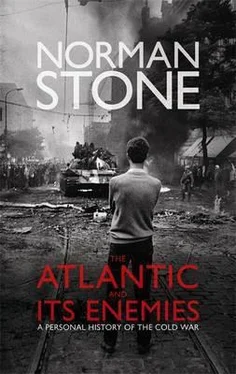The concomitant of the big state was printed money, which produced inflation, and inflation distorted everything. Augusto Pinochet led the field in what was to become a powerful counter-attack. His first move was to cancel the 300 per cent wage increases sanctioned by Allende, and some of the controlled basic prices were hugely increased. The great mass of the population had had its energy sapped, and accepted the immediate troubles easily enough, though no doubt the presence of the military helped. The essential move was to restrict the output of paper, which in turn meant a drastic curtailment of the State’s spending. There was no great secret in this: you needed some foreign support, high interest rates to prevent an expansion of borrowing, devaluation, and maybe bond sales at a well-judged rate, to attract some of the excess paper. These things had been done in 1923 in Germany, and a great inflation, which had brought the Mark to 11 billion against the dollar, stopped more or less overnight, in the context of a Communist takeover in Saxony (suppressed by the army, in what was known as a Reichsexekution ) and then Hitler’s first attempt to seize power, with the Putsch in Munich. There, the change had come about because, at last, a government stretching from some way into the Left to some way into the Right had been strong enough to maintain control. There were problems in the short run, with bankruptcies and unemployment, but there followed an economic recovery. Now, the first step in Chile was to carry through the money reform. Reducing inflation is a slow business, and in 1974 it still stood at over 500 per cent. Milton Friedman came on a visit in March 1975, and an economic recovery programme was announced. There were three phases of liberalization — the first to 1977, then a council of state in 1981 and a constituent assembly in 1985 with direct election every eight years provided for. A constitutional article forbade attacks on the family. Control of inflation meant, not just management of a paper currency, but attacking the causes of the inflation — what a prominent English politician, Sir Keith Joseph, with excellent American contacts, famously addressed at this time.
There would have to be a dismantling of the State. It meant privatization, to encourage efficiency through competition. The State, with ignorant investment of other people’s money, with over-employment, with automatic further credit from some puppet bank and with inappropriate political appointments, could in effect ruin concerns to the point at which no-one would buy them. No-one would make a profit out of them. In Chile some of the firms taken over by Allende had not been so ruined, and by 1978 all of the 259 sequestered firms had been returned to the stockholders, and ninety-nine others were sold off cheaply, mainly to conglomerates. There were two concomitants. The peso, though stable enough, was devalued, to the point at which imports from Chile became very cheap, and a further concomitant concerned the outside world: trade was widely liberalized, with foreign competition allowed. Tariffs sank to 10 per cent by 1978. There was a recovery, led by exports, and not just by the copper and other raw materials that Chile produced. There was now a property boom in Santiago, and there was a rehousing of the poor, away from the shanty towns into tower blocks well-segregated from middle-class areas, which experienced a property boom, because the tax on capital gains in property was abolished, and conglomerates ( piranhas ) made great gains out of the proceeds. Prices, generally, were removed from controls. On the sixth anniversary of the coup, Pinochet made a speech referring to the ‘seven modernizations’, which included a new labour code, and a new principle, of privatization, to be followed. This latter included social security: there would now be competition among private firms to provide insurance, rather than blanket coverage by the State. The new principle meant that education was also devolved — first onto the municipalities — while private schools were encouraged. The University of Chile and the Catholic University had been placed under the military, and were now expected to be self — financing. Privatized universities now became part of the intellectual agenda: this reflected the success of the American model, as against the decline of state universities in every other country.
Sergio de Castro became finance minister in December 1976 and surrounded himself with Chicago Ph.D.s who proposed textbook answers to the various problems. These became, quite soon, the stock-in-trade of the Western world, from the Atlantic to Turkey. There would be liberalization of foreign trade, and an end put to the practice of import substitution; the peso would be devalued as far as might be necessary to promote exports. On the other hand, credit would be restricted and interest rates put up in order for inflation to be stopped. These two aims were not always easy to combine, because high interest rates could push up the value of the peso, which might damage exporting. There was a further problem, that the course of privatization brought, at least in the short term, unemployment, although to some extent public works were used to counteract this. Given the overwhelming strength of the army, there was of course nothing that the trade unions could do while the reforms went ahead. Wages fell in purchasing power by half. Then matters began to improve, as the end of inflation meant that people started to save again.
The regime then had to contend with the ‘second oil shock’, when, in 1979, petrol prices doubled, and the country suffered from further difficulties when, in 1979, the British and Americans launched their own inflation cures, with a great fall in demand in 1980 and 1981. The rise of the dollar disrupted the exchanges, and in Chile, in 1982, there were many bankruptcies — 824, as against twenty-four in normal times, and unemployment reached beyond 20 per cent, while output fell by over 14 per cent. In 1983 the unemployment figure rose to 28.5 per cent and inflation also went up, from 9.9 per cent to 27 per cent. One problem was that the peso had been overvalued, and there had not been proper supervision of banks, which took dollar loans and lost the money in speculation. The de Castro team imagined that there would be some automatic adjustment, but by 1983 Pinochet himself realized that he must contain the crisis by state action. The claim was that the rich grew richer and that the gap between them and the poor widened — a not improbable claim. By 1978 conglomerates had emerged in force — Vial controlling twenty-five companies, Cruzat-Lorrain thirty-seven of the 250 largest ones, and six conglomerates held over half of their assets; there were press empires, and two of them took over 75 per cent of social security arrangements. Banks borrowed heavily from foreign fringe banks and then somewhat later ran into difficulties. In the later seventies interest rates were low and there was much borrowing once inflation had been halted: imports, debts and interest costs grew in 1980-81 as the dollar rose, and by 1982 a debt problem had emerged (in 1973 it had stood at $3.67bn but by 1982 it was over $17bn). The gremios — new private companies — suffered from foreign competition and in the last years of the seventies there were 1,338 bankruptcies. Even Vial and Cruzat-Lorrain went bankrupt and some bankers were prosecuted.
De Castro left office, succeeded by a more flexible man, José Piñera, who reorganized the entire world of pensions and welfare, devalued by 35 per cent and imposed tariffs again — not part of the original programme at all. Some of the banks were taken over, and their debts were underwritten by the State. Real wages were held down; they had fallen by one third between 1973 and 1975, and even in 1989 were still 90 per cent of the 1970 level. There was some labour unrest in 1983 and the copper workers staged a day of protest against the police, but wages were generally held down, and growth, at over 7 per cent, returned. Now, trade opened up: for instance, Chilean wine could be exported, and enterprising farmers worked out how they might grow new fruit — kiwi for instance. Once recovery was in place, by 1986, there was more privatization — utilities, mining and some services, and the banks that had been taken over were also sold off, as going concerns, this time with military money involved as ‘people’s capitalism’.
Читать дальше












![Edward Ellis - Adrift on the Pacific - A Boys [sic] Story of the Sea and its Perils](/books/753342/edward-ellis-adrift-on-the-pacific-a-boys-sic-s-thumb.webp)